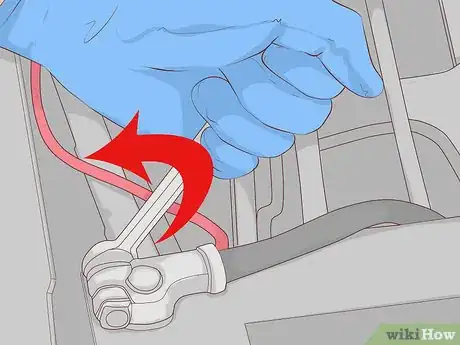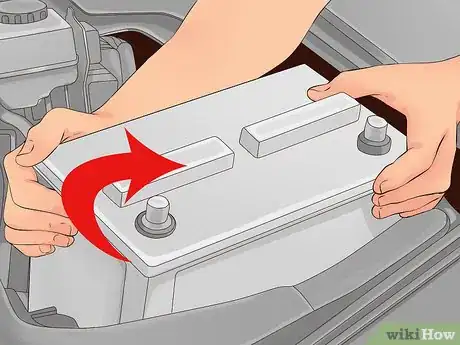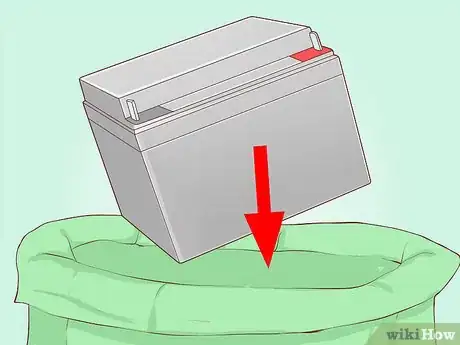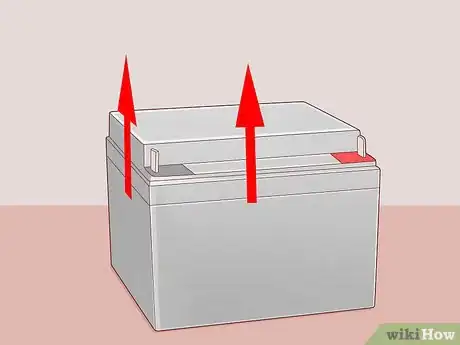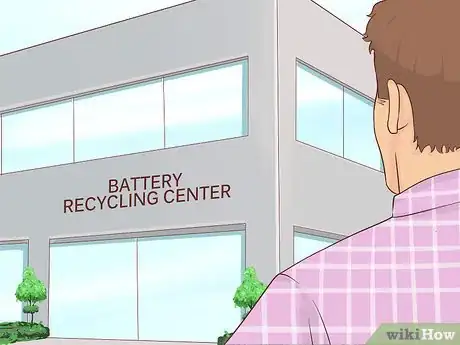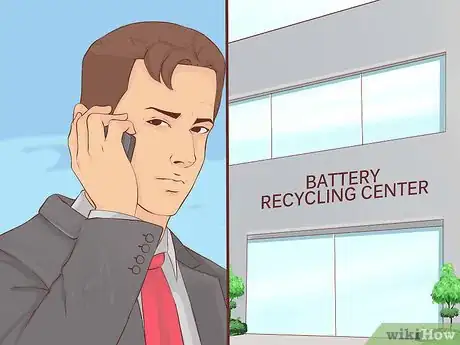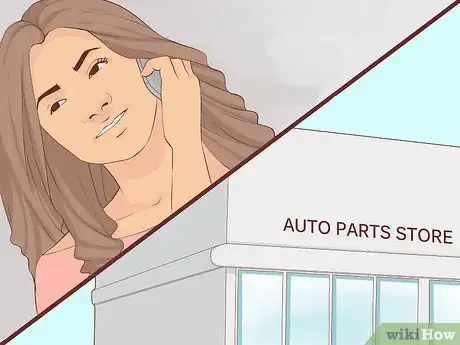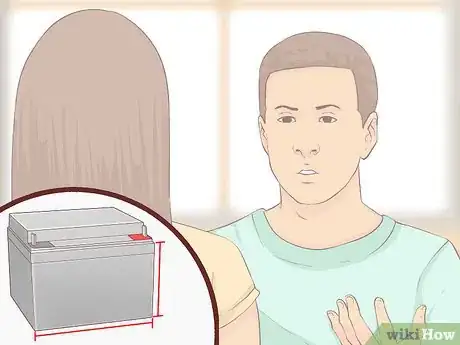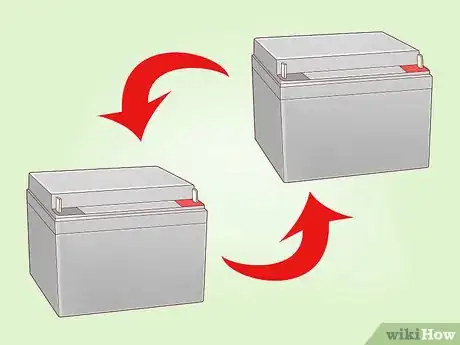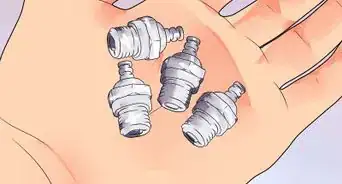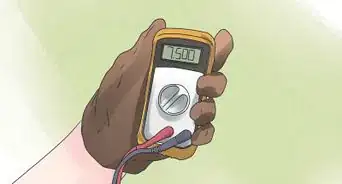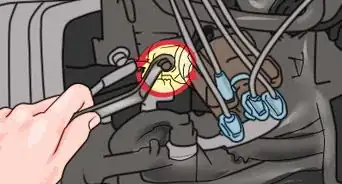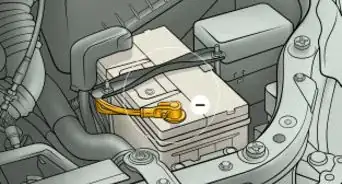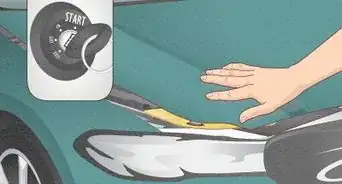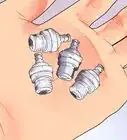This article was co-authored by wikiHow Staff. Our trained team of editors and researchers validate articles for accuracy and comprehensiveness. wikiHow's Content Management Team carefully monitors the work from our editorial staff to ensure that each article is backed by trusted research and meets our high quality standards.
This article has been viewed 139,029 times.
Learn more...
It is not safe for the environment for you to dispose of automotive batteries in the trash. Instead, batteries must be taken to certified recycling centers where they can be treated, and often reused. If you are replacing the battery in your vehicle, you may need to exchange the old one when purchasing a new one, otherwise, you will need to arrange to have the battery brought to a recycling center that accepts batteries.
Steps
Removing the Battery
-
1Wear the appropriate safety gear. Before removing an old battery from your vehicle, you should be prepared in the event the battery has leaked battery acid. Put on eye protection, as the fluids inside most batteries can be very dangerous for your eyes. Gloves are also a highly recommended precaution.[1]
- Goggle style eye protection will offer the highest degree of protection for your eyes.
- Gloves can prevent you from getting battery fluids on your skin, as they can be an irritant.
-
2Disconnect the battery. Use a hand or socket wrench of the appropriate size to loosen the nut on the negative terminal on the battery first. Remove the ground cable from the negative terminal and tuck it to the side, then repeat the process on the positive terminal.[2]
- Tuck both cables down and to the side to ensure they can’t come back into contact with the terminals as you remove the battery.
Advertisement -
3Remove the battery from the vehicle. Automotive batteries are secured into vehicles in a number of ways, so identify the strap or clip used to secure your battery in place and loosen or remove it so the battery can be removed. Often, this will require the removal of one long bolt.[3]
- If you are unsure of how to remove the battery from the vehicle, refer to the owner’s manual for guidance.
- Take care not to lose the fastening hardware, as you will need it to secure the new battery you put in.
-
4Visually inspect the battery for damage. If the battery has been crushed in an accident or punctured in some manner, it will be much more dangerous to transport. Check the battery for holes or leaks so you can be sure of what you are dealing with moving forward.[4]
- If there is a leak in the battery, you will need to be extremely careful not to get the fluid leaking out on your skin or in your eyes.
Preparing the Battery for Transport
-
1Wrap the battery in a plastic bag. The battery you remove from your vehicle will likely be covered in dirt and grime from the engine bay, so wrapping it plastic will keep that from staining the interior of your vehicle when you transport the battery to a recycling center.[5]
- If the battery is leaking, double wrap it in heavy duty trash bags to ensure the fluid doesn’t get on anything.
- You don’t need to tie the bags tight, as long as they stay upright.
-
2Keep the battery upright at all times. The only safe way to transport an automotive battery is sitting upright, so be sure you do not place it on the ground or in a vehicle on its side of upside down.[6]
- When transporting a battery, be sure it is positioned so it won’t fall over while you are driving.
- Some batteries have lids on the top that may open if tipped, draining the fluids from inside.
-
3Look up a local battery recycling center. You will need to bring the battery to a local recycling center that accepts automotive batteries. You can usually find this information on the city or town you live in’s website, or by doing an online search for local recycling centers.[7]
- The website Earth911.com can help you locate recycling centers in your area as well.
- Many auto repair facilities will also accept batteries for recycling.
-
4Contact the recycling center to establish a pickup or drop off. Contact the recycling center in your area and tell them what you hope to drop off. Some centers will come to your house and pick up the battery for you, but often you will need to deliver it yourself.[8]
- If the battery is leaking, make sure you tell them so before they come to pick up the battery.
- If you are transporting it yourself, be sure you have the address of the recycling center you are going to.
Recycling Your Battery When Replacing It
-
1Locate your local auto parts store. There are many auto parts stores that accept your old battery as a deposit toward a new one. If you need to replace your battery, wrap it in plastic and bring it to the auto parts store you intend to buy the new battery from.[9]
- You may want to call the auto parts store first to ensure they accept old batteries as a deposit.
- Be sure to drive the battery to the store wrapped in plastic and sitting upright.
-
2Request assistance locating a replacement battery. Speak to the clerk at the front desk to get help finding the specific size battery you will need in your vehicle. Provide them with the year, make and model of the vehicle, as well as the engine type if you know it.[10]
- If you are unsure of the type of engine you have in your vehicle, refer to the owner’s manual for assistance.
-
3Provide your battery as a deposit on the new one. When you purchase the new battery, the store will charge you an additional fee unless you provide a “core” battery as a deposit. The old battery you brought serves as that core. Trade them the battery in exchange for a lower price on your new one.[11]
- The store will have the battery drained and refurbished to be sold again as a new battery.
- You may have to pay more for a battery if you do not choose to recycle your old one through the auto parts store.
Community Q&A
-
QuestionAre car batteries left outside the car dangerous?
 Community AnswerCar batteries contain lead and sulfuric acid, and must be disposed of carefully. If you take it to an auto parts store, they might actually give you money for it. This is called a core charge; whenever you buy a new battery, this core charge is added onto the price, unless you turn in your old battery at the same time. When transporting your old batteries, make sure they don't fall over, or they can spill or leak. Chemical-resistant rubber gloves and safety goggles can protect against the nasty stuff inside. Wash your hands after handling car batteries.
Community AnswerCar batteries contain lead and sulfuric acid, and must be disposed of carefully. If you take it to an auto parts store, they might actually give you money for it. This is called a core charge; whenever you buy a new battery, this core charge is added onto the price, unless you turn in your old battery at the same time. When transporting your old batteries, make sure they don't fall over, or they can spill or leak. Chemical-resistant rubber gloves and safety goggles can protect against the nasty stuff inside. Wash your hands after handling car batteries. -
QuestionIs it dangerous to throw a battery in a river where you fish? What chemicals are released and how poisonous are they? My friend is doing this.
 Community AnswerThat's a really bad thing to do as it is polluting the water, will kill the fish and contaminate everything. Also, your friend could get in serious legal trouble for not disposing of them properly. You could get your friend to clean it up or get local authorities involved and they will clean it up. Tell your friend to stop.
Community AnswerThat's a really bad thing to do as it is polluting the water, will kill the fish and contaminate everything. Also, your friend could get in serious legal trouble for not disposing of them properly. You could get your friend to clean it up or get local authorities involved and they will clean it up. Tell your friend to stop.
References
- ↑ http://www.dummies.com/home-garden/car-repair/electrical-system/how-to-remove-and-install-a-car-battery/
- ↑ http://www.dummies.com/home-garden/car-repair/electrical-system/how-to-remove-and-install-a-car-battery/
- ↑ http://www.dummies.com/home-garden/car-repair/electrical-system/how-to-remove-and-install-a-car-battery/
- ↑ http://www.halfords.com/advice/motoring/expert-advice/battery-disposal-and-recycling
- ↑ http://www.dummies.com/home-garden/car-repair/electrical-system/how-to-remove-and-install-a-car-battery/
- ↑ http://www.halfords.com/advice/motoring/expert-advice/battery-disposal-and-recycling
- ↑ http://www.businessinsider.com/how-to-recycle-batteries-2015-10
- ↑ http://search.earth911.com/?what=Car+Batteries&where=new+york%2C+ny&list_filter=all&max_distance=25&family_id=&latitude=&longitude=&country=&province=&city=
- ↑ http://batterycouncil.org/?page=battery_recycling

